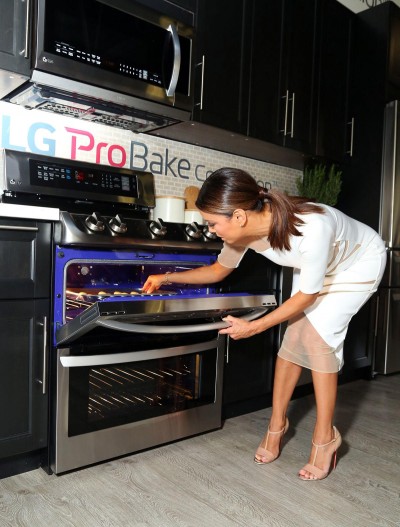 (BPT) – When it comes to food and cooking, Americans are becoming more adventurous and inspired to try new things. They buzz about the latest food trends with friends, share picture-worthy meals on their social feeds, binge on cooking shows and aspire to bring the unique dishes they eat in restaurants or see on TV to their own kitchens, recreating them for the entire family to enjoy.
(BPT) – When it comes to food and cooking, Americans are becoming more adventurous and inspired to try new things. They buzz about the latest food trends with friends, share picture-worthy meals on their social feeds, binge on cooking shows and aspire to bring the unique dishes they eat in restaurants or see on TV to their own kitchens, recreating them for the entire family to enjoy.
And it’s not just the parents who have become swept up in this cooking revolution. An impressive 93 percent of parents with children 4 to 17 years old report that their kids help out with food preparation at home, according to results of a national survey conducted for appliance maker LG Electronics.
“One of my greatest passions is being able to cook with those I love and create warm memories together over food,” says Eva Longoria, celebrity restaurateur and author of “Eva’s Kitchen: Cooking with Love for Family and Friends.” “It’s great to share that passion with those you love, but sometimes it’s not so easy to recreate what you see in restaurants or on TV. However, with the right equipment and a few tricks of the trade, the whole family can become home chefs and cook like the pros.”
Here are some tips to help achieve professional cooking and baking results at home:
1. Season smarter.
While the quality of your cooking skills and the dish ingredients are key, never underestimate the power that smarter seasoning can have on ensuring your dish is a real crowd pleaser. Any professional chef will tell you that it is essential to keep an extensive supply of fresh seasonings on hand, and not to be afraid to experiment to achieve new flavor combinations. The pros commonly add a little acid (think citrus or vinegar) to seasonings to help brighten food and take away the perception of some ingredients tasting bitter. You’ll also see them add woody herbs like rosemary, oregano, sage or thyme at the beginning of the cooking process, when they’re most effective at flavoring. Leafy herbs like parsley, chives, tarragon and basil do a better job of heightening flavors if you add them toward the end of the cooking process.
Does it seem like the food on restaurant menus and cooking shows gets more complex, perfectly executed and delicious every year? It probably does, and improved cooking technology plays a big part in producing these amazing results. While the cooking technology of bygone years was decidedly low-tech and made it difficult to achieve consistently great results, modern innovations like “ProBake” convection ranges from LG make it easier for home chefs to enjoy professional-style cooking at home. This new technology is a real game-changer for baking; the heating element is located at the back of the oven (rather than on the bottom), providing even heating on the top and bottom of every dish. Home chefs can take comfort in knowing that this kind of new professional baking technology means burnt cookie bottoms and unevenly cooked dishes are things of the past.
3. Bake better.
A great oven can inspire you to be bold with your baking. The more versatile you become in the kitchen, the better you will be at cooking those tried and true favorites, maybe even giving them a new spin. If you’ve always stuck to cookies, try your hand at pastry making. If cakes have always been your forte, experiment with bread. There are so many professional tips to help you make the plunge. One pro-level tip to achieve a crust on your yeast breads entails preheating your oven to a higher temperature than the recipe recommends. Then once you put the bread in the oven, lower the temperature back down to what the recipe specifies. Keep chocolate baked goods moist and flavorful by removing them from the oven exactly on time; crumbs should be moist when you take chocolate items out of the oven. Bake cookies until the edges are just firm and they look the tiniest bit underbaked – when they cool, they’ll be soft and chewy.
4. Maximize your meats.
Roasting can be a healthful and flavorful way to prepare meats of all kinds, from beef roasts to whole chickens, turkeys and ducks. Most cuts of meat will taste better if marinated before cooking. To make the most of your marinade, remember to prick the meat or make shallow slashes with a knife so the marinade can soak into the meat. Always marinate meats, fish and fowl in the refrigerator. Most roasted meats will taste better if you allow them to ‘rest’ outside the oven before slicing and serving. This allows the juices to redistribute throughout the meat.
Ready to try your hand at baking like a pro at home? Here’s a palate-pleasing recipe from Longoria’s cookbook “Eva’s Kitchen” to get you started:
 Pan de Polvo (Mexican shortbread cookies)
Pan de Polvo (Mexican shortbread cookies)
Yield: About eight dozen cookies.
Ingredients
2 1/2 cups all-purpose flour
1 teaspoon ground cinnamon
1 cup shortening
1/4 cup sugar
For the sugar coating
1 cup sugar
2 tablespoons ground cinnamon
Directions:
In a medium bowl, place the flour and cinnamon. Whisk together until thoroughly blended. Set aside.
In the work bowl of an electric stand mixer, fitted with the paddle attachment, or in a large mixing bowl with a handheld mixer, beat the shortening and sugar on medium-high speed until well blended and fluffy – about 20 minutes. Add 2 tablespoons of water and beat until thoroughly combined.
Add the flour mixture and blend on medium-low just until completely blended. Press the dough into two equal disks. Place each disk between two sheets of wax paper. Use a rolling pin to roll out each disk to 1/8-inch thick, lifting and smoothing the top of wax paper if necessary. Slide the two sheets of rolled dough onto a baking sheet. Chill until firm, about 30 minutes in the refrigerator or 10 minutes in the freezer.
Preheat the oven to 300 F.
Place one rolled dough on the work surface. Lift off and replace the top sheet of wax paper. Flip the dough over and lift off and set aside the sheet of wax paper. Use a 1 1/2 -inch or smaller cookie cutter to cut into desired shapes. Transfer the cookies to an ungreased baking sheet, placing about 1 inch apart. Gather the scraps, reroll them between the sheets of wax paper, and refrigerate until firm. Repeat with the other sheet of dough.
Bake until firm when gently touched, 10 to 12 minutes. Let cool 3 minutes on the cookie sheet. Use a thin spatula to transfer them to cooling racks to cool completely.
To prepare the sugar coating, place the sugar and cinnamon in a shallow dish. Stir with a fork until completely combined. Roll the cooled cookies in the sugar and serve. Store in a tightly covered container at room temperature for three to four days.


